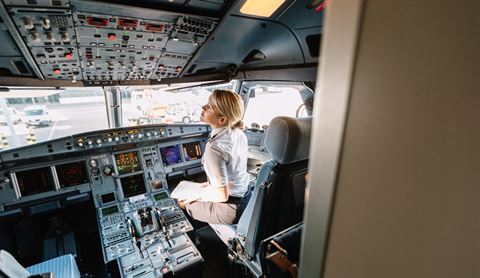THE FLIGHTDECK • January 2019
Pilot talk: Amie Kirkham
Do you have what it takes to become a pilot? Between flying planes from Heathrow and motivating young aviation fans on behalf of British Airways, First Officer Amie Kirkham chats with The Club about the skills you need, the myths you can forget, and the destinations that have her coming back for more
I’ve always known I wanted to be a pilot
It’s been a dream of mine from a young age. In fact, when I left junior school aged 10, I took part in a leavers assembly where we dressed up and said a few lines about our career aspirations… I was dressed as a British Airways Captain (complete with massively oversized jacket) and told everyone about my dream to fly the Boeing 747. True story!
Being a successful pilot requires a medley of skills
Obviously it is essential to have proficient technical ability, spatial awareness and coordination, but great communication and teamwork skills play a huge part, because every flight involves working alongside a range of colleagues. You also need that specific ability to see the details and the big picture at the same time.
The autopilot does not fly the aircraft for us
Much like your work computer, there are systems to help us achieve what we need to, but we still make the decisions. While the autopilot is great for controlling certain aspects of the aircraft, we are required to monitor constantly that the system is doing what we’ve asked. Autopilot is never used for take-off, but we can use it for an auto land when there is low visibility. However, this is very rare – pilots make manual landings 99 per cent of the time.
I love flying in and out of Nice
We fly in over the Alps – always breathtaking – then low over the Mediterranean Sea with spectacular views of the coastline and Nice’s Promenade des Anglais. It can be a challenging approach… complicated, but beautiful.
Flying is a massive thrill
Taking off out of Heathrow (the world’s second-busiest airport) and climbing out over London never gets boring. The views from ‘my office’ are amazing and I’m lucky to be able to explore beautiful European cities. I also feel privileged to fly with incredibly professional and passionate colleagues.

Staying on course: Amie checks flight paths at Heathrow's headquarters
Which destination would you recommend everyone visit at least once?
It would be Cape Town. I have family there so I visit often, but I never tire of the lovely weather, beautiful scenery and fascinating local culture. Exploring the Garden Route along the south coast is a journey everyone should undertake – watching whales in Hermanus on the Western Cape is bucket-list stuff.
I always make sure my gym kit is packed
When we have overnight stops, it’s a great opportunity to make the most of the hotel fitness facilities. Our job involves a lot of sitting, so it’s important to move about and stay fit. A good book is a must, and I always pack my Bose travel speaker.

Female pilots remain a rarity
Being a pilot is still not an obvious career choice for women. At British Airways we’ve been recruiting female pilots for more than 30 years and the percentage of our female flight crew is currently more than six per cent, double the national average. Our Flying Futures evenings are part of a portfolio of activities run by flying colleagues to encourage young people into aviation; others include visits to schools, colleges and recruitment events.
I recently met an incredibly cute six-year-old
She visited the flight deck after landing, dressed up in the full pilot’s uniform she wears every time she flies. She proudly announced that her dream was to become a BA Pilot, and was delighted to find ‘another girl’ in the cockpit. I was thrilled to meet her and so impressed with her passion at such a young age.

Landing an empty Airbus A320 was an exhilarating experience
It was my first flight at the A320 controls, having just finished two years of training. Before we can fly passengers we undertake ‘base training’, demonstrating safe take-offs and landings at a remote airfield in France. It was an amazing feat for me at the time and hugely satisfying after years of studying and training.
Do you have what’s needed to become a British Airways pilot? Click here to find out
This article has been tagged BA, Travel Tips
More from previous issues

How to be a great Dane
Zenmark: When it comes to winter wellness, the Danes have all the answers. And now, thanks to Chart Design Fair director Nanna Hjortenberg, so do we

The Guru: The cabin crew vlogger
The Club speaks to cabin crew member and vlogger Thyra Adjei, who’s been meeting the people who keep BA at the top of its game

Where we went, and where we’re going next
From New England to Japan, The Club’s editorial team divulge their best trips of this year, and which destinations are already tempting them for 2019

Six of the world’s best hidden beaches
From Austria's famously pure pools to city beaches in Eastern Europe, we ask one travel writer to uncover the best hidden beaches for sun and seclusion
